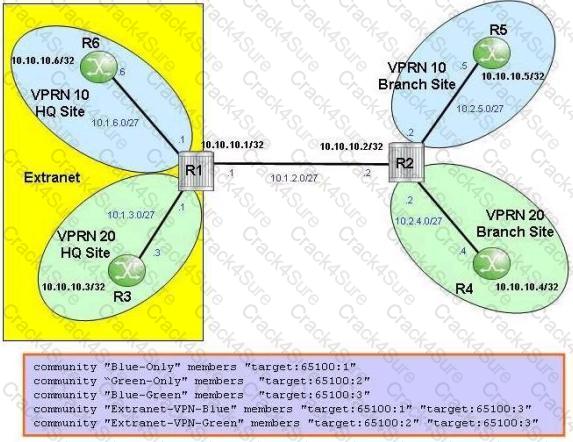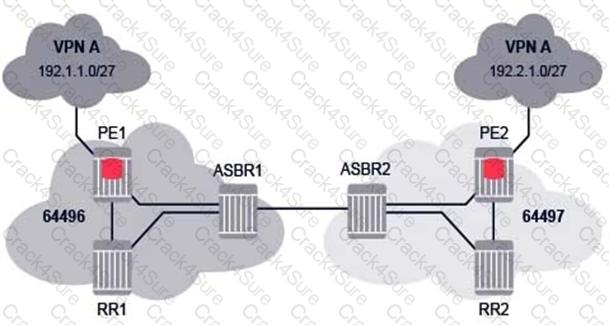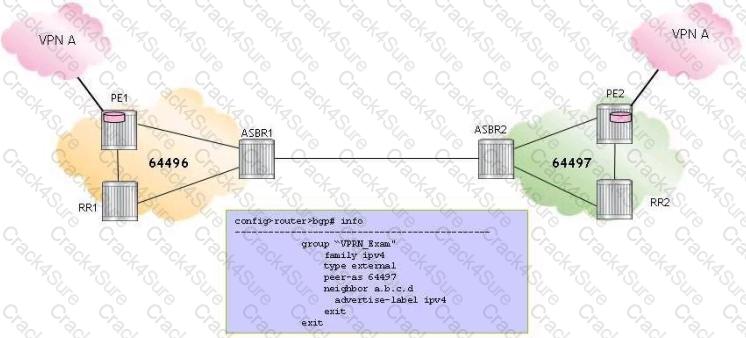We at Crack4sure are committed to giving students who are preparing for the Nokia 4A0-106 Exam the most current and reliable questions . To help people study, we've made some of our Nokia Virtual Private Routed Networks exam materials available for free to everyone. You can take the Free 4A0-106 Practice Test as many times as you want. The answers to the practice questions are given, and each answer is explained.
Click the exhibit.

A Carrier Supporting Carrier (CSC) VPRN is configured for a customer carrier who is a BGP/MPLS service provider. If CE1 sends an IP packet to 192.168.200.1, which of the following is FALSE?
What operation does a P device perform when it receives a labeled packet for a VPRN service?
When VPRN Outbound Route Filtering (ORF) is enabled, each PE sends its ORF list to its peer using which of the following BGP message types?
Click the exhibit.

If the displayed command is executed, what is the correct value of AS-Path in the BGP route 172.12.0.0/16 advertised by PE2?
Click the exhibit.

For the CE hub and spoke VPRN, which of the following is FALSE?
Click the exhibit.

The headquarter sites of VPRN 10 and VPRN 20 are part of an extranet VPRN. Which route targets should be exported under the VPRN 20 service on router R1?
Click the exhibit.

For the Inter-AS model B VPRN, which of the route updates for prefix 192.168.1.0/27 is incorrect?
For the data packets in a VPRN, how is the inner label in an MPLS packet signaled?
Community lists are configured for the PE hub and spoke VPRN.

Which communities should be imported by the VPRN service on PE1?
Click the exhibit.

For the inter-AS model B VPRN, which of the following is TRUE when CE2 sends an IP packet to 192.168.1.1?
Which of the following about the configuration of BGP Site of Origin (SoO) is TRUE?
Based on the VPRN BGP decision process, which of the following routes is selected first?
Click the exhibit.

The AS-override method is used to prevent BGP loops in the blue customer VPRN. Which statement about the configuration is TRUE?
Click the exhibit.

AS-override is configured on PE1 to eliminate the BGP loops. What is the expected AS-Path in the VPN-IPv4 route 64496:10:192.168.2.0/27 received by PE1?
Click the exhibit.

An Nokia 7750 SR is to be configured as a PE router that supports VPRNs using LDP as the transport protocol. Which of the following best describes this configuration?
For a Carrier Supporting Carrier (CSC) VPRN where the customer carrier is an ISP that provides Internet connectivity to its end-customers, which of the following is TRUE?
Click the exhibit.

How many route targets and route distinguishers are required to implement the extranet VPRN?
Which of the following is not a valid BGP design for a network provider supporting VPRNs?
Click the exhibit.

The headquarter sites of VPRN 10 and VPRN 20 ate part of an extranet VPRN. Which of the following communities are included in the export policy applied to VPRN 10 on router R1?
In inter-AS model C VPRN, which of the following about the command "advertise-label ipv4" is TRUE?
When using the AS-override method to prevent BGP loops in VPRNs, where should the "as-override" CLI command be configured?
Which of the following about VPRN Outbound Route Filtering (ORF) is FALSE?
Which of the following about inter-AS model C VPRN is FALSE?
Click the exhibit.

The displayed output is from an ASBR supporting an inter-AS model A VPRN. Which of the following statements about this output is TRUE?
How are local CE routes associated with the appropriate VRF at the PE?
For a Carrier Supporting Carrier (CSC) VPRN where the customer carrier is a BGP/MPLS VPN service provider, which of the following is TRUE?
For the Inter-AS model C VPRN, which of the following is FALSE when an IP packet is sent from 192.1.1.1 to 192.2.1.1?

Click the exhibit.

Community lists are configured for the PE hub and spoke VPRN. Which communities should be exported by the VPRN service on PE1?
When an Nokia 7750 SR receives a BGP update containing an AS-Path loop, what is the default action?

Click the exhibit.

A Carrier Supporting Carrier (CSC) VPRN is configured on an Nokia 7750 SR for a customer carrier who is an Internet Service Provider (ISP). Which of the following configuration steps is NOT required?
In a VPRN, which of the following are supported as PE-CE routing methods on the Nokia 7750 SR? (Choose four).
Which command is required in the blank line to complete the configuration shown below on an Nokia 7750 SR?


Click the exhibit.

For the inter-AS model B VPRN, which of the following is FALSE when CE2 sends an IP packet to 192.168.1.1?
What are the main functions of a Layer 3 VPN? (Choose three).
What operation is performed by a P device on the label signaled by MP-BGP when it receives a labeled packet for a VPRN service?
Which of the following is not an available option for Route Distinguisher assignment?
Click the exhibit.

Which of the following commands produces the output for the inter-AS model B VPRN?
Which of the following statements best describes the output from an Nokia 7750 SR shown below?
In a VPRN the PE device is configured to run which of the following protocols? (Choose three.)
VPN-IPv4 addressing is made unique by defining an address structure consisting of:
Choose the best answer to describe the result of the configuration of an Nokia 7750 SR shown below?
When would it be appropriate to use the as-override command?

Which of the following statements are true regarding P devices in an MPLS VPRN? (Choose two.)
Why would a selective export policy be applied to a customer VPRN service? (Choose three)
In a Carrier Supporting Carrier (CSC) VPRN, which of the following is a benefit to the network provider?
Click the exhibit.

For the Carrier Supporting Carrier (CSC) VPRN, which routes are advertised between CSC-CE1 andCSC-PE1?
Click the exhibit.

A Carrier Supporting Carrier (CSC) VPRN is configured for a customer carrier who is a BGP/MPLS service provider. Which route is present in PE1's global routing table?
Which of the following statements is true regarding the Route Distinguisher? (Choose three)
What command is required to configure the PE devices for a VPRN service on an Nokia 7750 SR?
Click the exhibit.

A Carrier Supporting Carrier (CSC) VPRN is configured for a customer carrier who is a BGP/MPLS service provider. If CE1 sends an IP packet to 192.168.200.1, which of the following is FALSE?
Which of the following describes the goal of an Extranet VPRN?
Which of the following about BGP Site of Origin (SoO) is FALSE?
What is the minimum number of Route Distinguishers required to implement an overlapping VPRN involving 5 different customers?
Which of the following about an Nokia 7750 SR MP-BGP update is FALSE? Assume default behavior.
Which command should be used on an Nokia 7750 SR acting as the PE, to view the table containing the BGP routes received from the remote sites?
Complete the following statement. In a VPRN, the label signaled by RSVP-TE is used to ______________.
Which of the following about inter-AS model AVPRN is TRUE?
Click the exhibit.

For the inter-AS model C VPRN, which router is configured as shown?
Click the exhibit.

Which of the following best describes the output?
3 Months Free Update
3 Months Free Update
3 Months Free Update